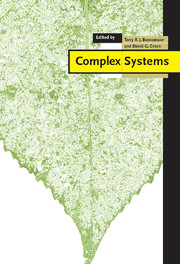Book contents
- Frontmatter
- Contents
- 1 Introduction
- 2 Self-organisation in complex systems
- 3 Network evolution and the emergence of structure
- 4 Artificial life: growing complex systems
- 5 Deterministic and random fractals
- 6 Non-linear dynamics
- 7 Non-linear control systems
- 8 Parallel computers and complex systems
- 9 Are ecosystems complex systems?
- 10 Complexity and neural networks
- Index
1 - Introduction
Published online by Cambridge University Press: 04 August 2010
- Frontmatter
- Contents
- 1 Introduction
- 2 Self-organisation in complex systems
- 3 Network evolution and the emergence of structure
- 4 Artificial life: growing complex systems
- 5 Deterministic and random fractals
- 6 Non-linear dynamics
- 7 Non-linear control systems
- 8 Parallel computers and complex systems
- 9 Are ecosystems complex systems?
- 10 Complexity and neural networks
- Index
Summary
Overview
Imagine a violent storm sweeping across a beach. The wind picks up debris, swirls it around madly, dumping it somewhere else. Devastation remains, structure and order are gone. But one of the great waves of interest to break over science in the last decade has been the delicate balance between order and disorder: the patterns which appear out of nowhere through self-organisation; the fine structure of chaotic dynamics; the long range order which appears at phase transitions.
Fractal geometry in the 1970s moved from abstract mathematics to real world applications: simple rules could generate complex structures of great symmetry over an infinite range of scales. Chaos caught many peoples' imagination in the 1980s: simple rules could produce arbitrarily complex patterns which appear quite random. As the millennium draws to a close, more and more of these phenomena seem like different aspects of an underlying paradigm: complexity. Not just a new scientific theory or body of data, it challenges fundamental attitudes to the way we do science.
Although it might be intuitively apparent that a system is complex, defining complexity has proved difficult to pin down with numerous definitions on record. As yet there is no agreed theory of complexity. Much of the mathematics is intractable and computer simulation plays a major part. Thus in this book we do not try to present a uniform theory of complexity, nor do we try to describe or characterise many complex systems. We try to present the major theoretical tools and mathematics which help us along the way to these much more lofty goals.
- Type
- Chapter
- Information
- Complex Systems , pp. 1 - 10Publisher: Cambridge University PressPrint publication year: 2000



